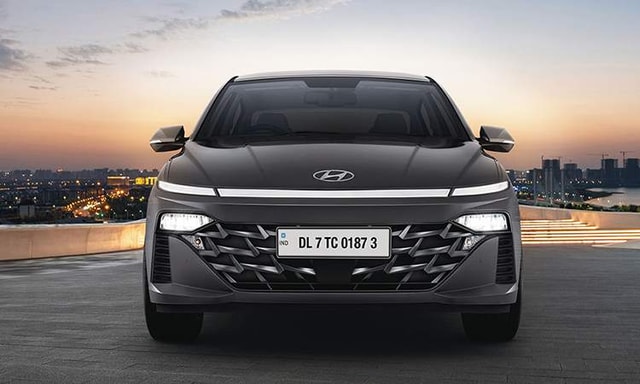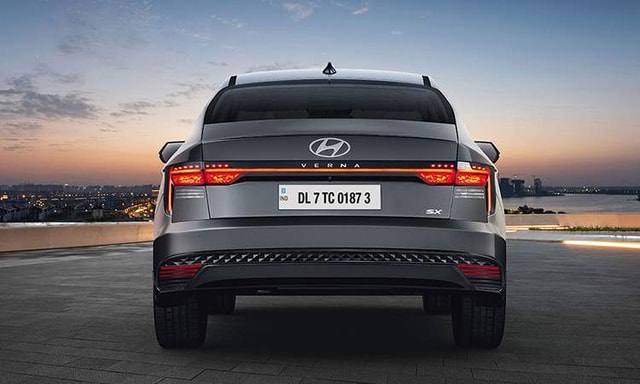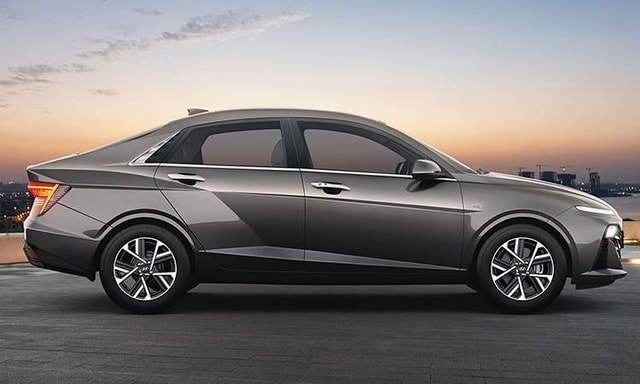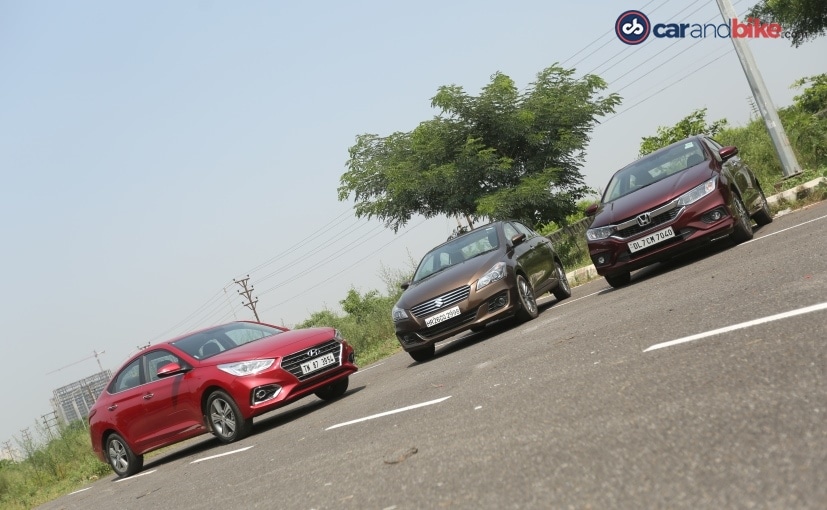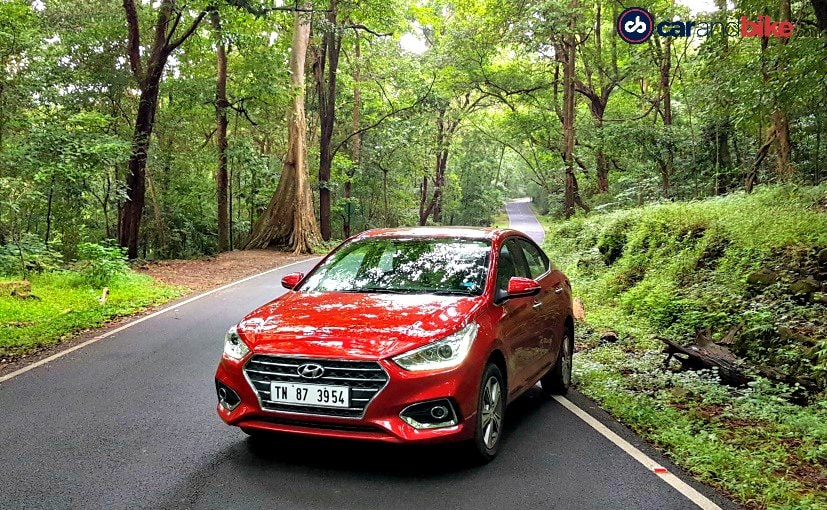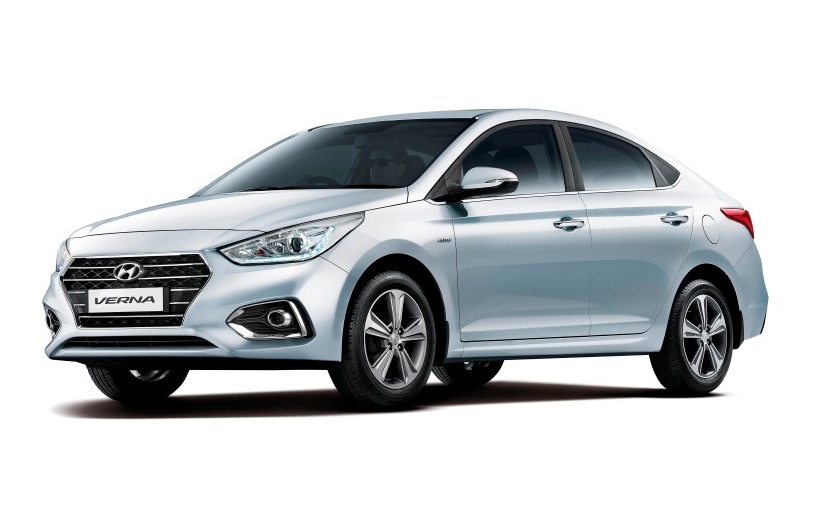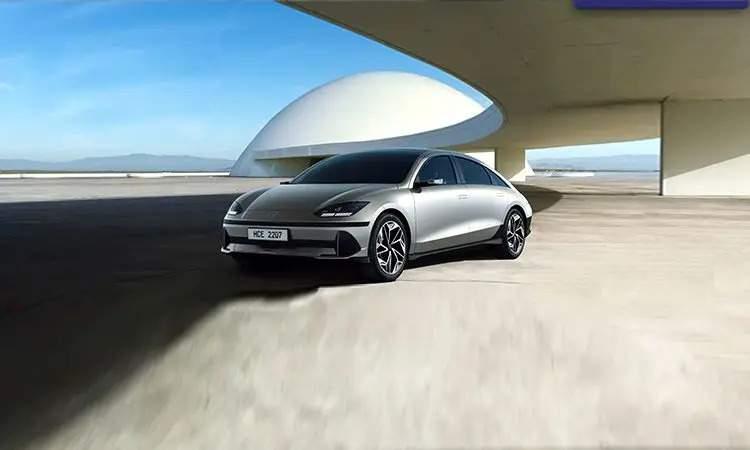New Hyundai Verna
New Hyundai Verna is a 5-seater Sedan available at a starting price of Rs. 10.69 Lakh. The car is available in 17 variants, with 2 engine and 4 transmission option. Additionally, New Verna offers a Ground Clearance measurement of 170 mm and a Boot capacity of 528 liters. You can choose from 9 colors for the New...
New Hyundai Verna
Hyundai New Verna Colours
Hyundai New Verna is available in 9 different colors namely Abyss Black, Atlas White, Fiery Red Dual Tone, Tellurian Brown, Typhoon Silver, Fiery Red, Titan Grey, Starry Night & Atlas White Dual Tone.
Latest Updates on Hyundai New Verna
Hyundai Verna Facelift Spied Testing In India Ahead Of Expected Debut In 2026
Updated Hyundai Verna Gets Rear Spoiler; Prices Hiked By Rs 6,000
8000 km Long Term Review: 2023 Hyundai Verna SX(O) Turbo/DCT
Hyundai Verna Secures Five-Star Rating In Global NCAP Crash Tests
New 2017 Hyundai Verna Spotted Testing In India
New Verna Safety Ratings
Hyundai New Verna Price List (Variant Wise)
Hyundai New Verna Ex-Showroom price ranges from ₹ 10.69 to 16.98 Lakh. Hyundai offers New Verna in 17 variants. The top variant of New Verna is 1.5 Turbo GDi SX (O) DCT Dual Tone and the base variant is 1.5 MPI EX MT.
Expert Review on Hyundai New Verna
- Expert Rating
8.5/10
- Safety8Comfort8.75Styling8.75Merit / USP9Significance8.75Value for Money8.75
Hyundai Verna
The Hyundai Verna was always an admired sedan in the country. It has surmounted several competitors and challenges en route toward becoming one of the company’s most successful sedans in the Indian market. The Verna first arrived in 2011 and got another makeover in 2017, followed by an updated version in 2020.
The Verna gets a refreshed and attractive design as has been its hallmark for several years. There is a bigger and frameless grille in front, along with a sportier look and creases and cuts aplenty. The fog lamps are swept back and a tiny spoiler is present as well. The coupe-Esque roofline and the boot spoiler come from the previous version while the new alloys also look stylish enough. The Verna has also been raised slightly, giving it a taller stance. The exhaust tips get a chrome finish at the back although the lower bumper treatment does not look as appealing (although opinions are subjective).
Pros
- Good Features
- Varied Engine Options
- Smart Trunk Feature
Cons
- Stiff Suspension
- Dated Interiors
- Handling Could Be Better
Verdict
The Verna is reloaded and back. Is there enough here to impress? Yes. Don't get us wrong there could have been more - if you want to be greedy! But for the most part. The car remains one of the most modern, relevant, connected offerings with a huge array of variants to fit many budgets. And a lot of the equipment is standard across variants. The Toyota Yaris has failed to make a dent in this segment, though has its merits.
New Verna Image Gallery
Browse through a collection of 30 high-quality images showcasing both the exterior and interior of the Hyundai New Verna
Hyundai New Verna Mileage
New Hyundai Verna mileage is 18 to 20 KM/L as per ARAI The Manual Petrol engine has a mileage of 20 KM/L. The Automatic Petrol engine has a mileage of 20.6 KM/L. The DCT Petrol...
| Fuel Type | Transmission | Mileage | City Mileage | Highway Mileage |
|---|---|---|---|---|
| Petrol | Manual | 20 KM/L | 17 KM/L | 19 KM/L |
| Petrol | Automatic | 20.6 KM/L | 17 KM/L | 19 KM/L |
| Petrol | DCT | 20.6 KM/L | 17 KM/L | 19 KM/L |
| Petrol | IVT | 19.6 KM/L | 17 KM/L | 19 KM/L |


Quick Compare with Hyundai New Verna Competitors
 Hyundai New Verna 10.69 - 16.98 Lakh |  Maruti Suzuki Ciaz 10.32 - 13.99 Lakh |  Honda City 11.95 - 16.07 Lakh |  Skoda Slavia 10 - 15.93 Lakh |  Volkswagen Virtus 12.36 - 15.99 Lakh |  Maruti Suzuki 2025 New Dzire 7.45 - 11.58 Lakh |
|---|---|---|---|---|---|
Ex-Showroom Price ₹ 10.69 - 16.98 Lakh | ₹ 10.32 - 13.99 Lakh | ₹ 11.95 - 16.07 Lakh | ₹ 10 - 15.93 Lakh | ₹ 12.36 - 15.99 Lakh | ₹ 7.45 - 11.58 Lakh |
C&B Expert Rating 8.5 | 7.0 | 8.2 | 8.3 | 8.3 | - |
Engine 1482,1497 cc | 1462 CC | 1498 CC | 999 CC | 999 CC | 1197 CC |
Transmission Manual, Automatic, DCT, IVT | Manual | Manual | Manual | Manual | Manual |
Mileage 18 - 20 KM/L | 20.04 - 20.65 KM/L | 17.8 - 18.4 KM/L | 18 - 20 KM/L | 18.67 - 19.4 KM/L | 22 - 24.7 KM/L |
Fuel Type Petrol | Petrol | Petrol | Petrol | Petrol | Petrol |
Seating Capacity 5 Seater | 5 Seater | 5 Seater | 5 Seater | 5 Seater | 5 Seater |
Fuel Tank Capacity 45.0 L | 43.0 L | 40.0 L | 45.0 L | 45.0 L | 37.0 L |
No of Variants 17 | 9 | 8 | 24 | 3 | 8 |
Detailed Comparision - |
Hyundai New Verna EMI Calculator
Read User Reviews of New Verna
- 4.0User RatingTap To Rate:
- 543%433%313%23%110%
- Do You Own This New Hyundai Verna?Share your experience about New Hyundai Verna
- Experience with the Verna 2018 deisel manual so far...5.0Anniversary Edition Diesel(Diesel)PerformanceMileageComfortCost of OwnershipValue for MoneySafetyStylingSales SupportI've always been in love with this car. Especially the 2018 Verna. The price remained a concern and I was sure that I wouldn't buy a different car since Verna has features that no other car in this segment could provide. I looked at a few used one's primarily to understand the differences and also see if it was worth paying the extra amount. Hence after a lot of contemplation I moved ahead with my purchase of the verna 1.6 sx(o) anniversary edition diesel. I did about 6 test drives before I made the purchase. I'd read on a lot of reviews that the breaks were not upto the mark. I too felt that on the test drive cars. However on the 6th attempt I was sent a 500kms driven petrol auto to specifically test the breaks and I'm happy to say that they were razor sharp! I took the delivery of my car from Kothari hyundai (Kharadi Pune) on the 1st of november. I've driven about 1900 kms and there haven't really a lot of bad experiences (Will cover that in a bit) till date. The car is butter smooth. The handling is like no Hyundai I've ever driven (I started off with the first gen i20 and then moved to the elite i20. We also got a creta earlier this year). One of my key requirements was good FE. I'm glad to report an average of about 19 in city with normal traffic. I've had a few highway test runs. On most of them I used to set the cruise control to 100 (only on the express way). Trips to lonavala returned an average of 21.8 to 22.3 kmpl. (All 3 done on sundays with quite a lot congestion. Figures are for about a 180 kms return journey). The steering is light but doesn't feel disengaged even in high speeds unlike the previous generations. On a mahabaleshwar trip I touched 172 kmph (after the 1st service) and I still got an average of more than 20 kmpl which I think was simply fab. Now coming to some of the not so great parts, I feel the seats are a little to hard and don't provide ample thigh support. I'm 6ft and there isn't enough room for ppl like me to be seated in the rear. I really don't understand why they couldn't offer led headlights. While the halogen do the work but I always felt the LED's could have done a better job. It also looks a lil odd since the Day light running leds are white, so are the projector for lamps. The halogen headlight does look a little odd. But these are certainly not real breakers. Long story short, though it's probably the most expensive car in it's segment. It surely lives up to the expectations. Certainly is an amazing car.By ParijatPosted on: Dec 01, 2019 11:31 PM103
- Good performance in highways5.01.6 CRDi SX (O)(Diesel)PerformanceMileageComfortCost of OwnershipValue for MoneySafetyStylingSales SupportGood performance in highways. Only the point is ground clearance is too low . One more thing is while giving more acceleration some sound like (water gargling ) from the engine or inside the dash board. This is SX (O) Diesel . Rest overall is good performance. I like the car very muchBy Deepak RoyPosted on: Nov 24, 2019 02:54 PM01
- Spacious and comfortable5.01.5 MPI SX (O) iVT(Petrol)PerformanceMileageComfortCost of OwnershipValue for MoneySafetyStylingSales SupportThe Verna’s new look is impressive. The car is stylish and packed with features. The cabin is spacious and comfortable, with high-quality materials and a well-designed dashboard. The ride quality is smooth, and the car is very stable at high speeds.By Hardik MunarPosted on: Sep 16, 2024 04:03 PM00
- Verna SX VTVT review5.0New VernaPerformanceMileageComfortCost of OwnershipValue for MoneySafetyStylingSales SupportBought Verna SX VTVT from Trident Hyundai, Bangalore (June 2019) Car Performance : Awesome Fuel efficiency : 11 KM/L in City traffic, very congested Road 16.5 to 17.5 on Bangalore - Hyderabad Highway 2000 Km driven so farBy MaheshPosted on: Aug 29, 2019 08:54 AM01
- Verna look is aowesome5.0New VernaPerformanceMileageComfortCost of OwnershipValue for MoneySafetyStylingSales SupportApart from mileage no other drawback it has. Also look like a premium car so basic or sx any one you can buy interior also good. Comparatavely it's a worthy to buyBy Girish M HPosted on: Aug 23, 2020 07:06 AM21
What's New on Hyundai New Verna?
The Hyundai Verna is a stylish compact sedan that has been a favorite among car enthusiasts since its initial launch in 2006. Known for its sleek design, modern features, and powerful engine options, the Verna continues to impress with each new iteration. The latest model, the 2023 Hyundai Verna, takes things up a notch with even more advanced features and a refined aesthetic that sets it apart from the competition. The Hyundai Verna 2023 is available in both petrol and diesel engine options, catering to a wide range of preferences and driving needs. The petrol variants are equipped with a 1.5-liter engine, while the diesel options feature a 1.5-liter CRDi engine. These engines are paired with multiple transmission options, including a 6-speed manual, a 6-speed automatic, and a 7-speed dual-clutch automatic, ensuring a smooth and responsive driving experience. When it comes to pricing, the Hyundai Verna price in India is competitive, making it an attractive choice for buyers looking for a high-quality sedan. The Hyundai Verna on-road price includes taxes, registration, and insurance, and can vary depending on the city and selected variant. The Hyundai Verna top model price offers additional luxury features and enhancements for those seeking a premium driving experience. Inside the Hyundai Verna, you'll find a spacious and well-appointed interior designed with comfort and convenience in mind. The Hyundai Verna interior boasts a touchscreen infotainment system with Android Auto and Apple CarPlay compatibility, wireless charging, and a sunroof, providing a truly modern driving experience. The cabin is thoughtfully designed with premium materials and ergonomic seating, ensuring a comfortable ride for all passengers. Safety is a top priority for the Verna, with features such as ABS with EBD, front and side airbags, and a rear-view camera included as standard. The car's impressive safety credentials make it a reliable option for buyers in the compact sedan segment. The Hyundai Verna S+ variant offers a balanced mix of features and performance at a reasonable price point, while the new Hyundai Verna introduces design updates and technology improvements that further enhance its appeal. The Hyundai Verna 2024 is anticipated to continue this trend, with even more innovative features and enhancements. For those interested in the specifics, the Hyundai Verna mileage is commendable, with the petrol variant offering around 17 km/l and the diesel variant delivering approximately 25 km/l, making it an economical choice for daily commutes and long drives alike. With its sleek design, advanced features, and impressive performance, the Hyundai Verna car remains a top contender in the compact sedan market. Its combination of style, technology, and efficiency makes it an ideal choice for buyers seeking a modern and reliable vehicle. Whether you're considering the Hyundai Verna 2023 price in India or exploring the latest features of the Hyundai Verna new model, this sedan continues to be a smart choice for discerning drivers.
Key Highlights:
Ex Showroom Price
From ₹ 10.9 Lakh Onward
Seating Capacity
5
Mileage
19-21 KM/L
Transmission
Boot Space
528L
Class
Fuel Capacity
45L
Base Model
Top Model
Similar Models
Key Features of Hyundai New Verna
 Horizon LED positioning Lamps & DRLs
Horizon LED positioning Lamps & DRLsThe Hyundai Verna is equipped with horizon LED...
Hyundai New Verna Price in Top Cities
| New Delhi | ₹ 12.15 Lakh |
| Mumbai | ₹ 12.36 Lakh |
| Bangalore | ₹ 12.90 Lakh |
| Hyderabad | ₹ 12.04 Lakh |
| Chennai | ₹ 13.00 Lakh |
| Kolkata | ₹ 11.42 Lakh |
| Pune | ₹ 12.36 Lakh |
| Mysore | ₹ 12.89 Lakh |
| Chandigarh | ₹ 12.14 Lakh |
| Ahmedabad | ₹ 11.72 Lakh |
| Lucknow | ₹ 12.14 Lakh |
| Allahabad | ₹ 12.14 Lakh |
| Agra | ₹ 12.14 Lakh |
| Jaipur | ₹ 11.93 Lakh |
| Nagpur | ₹ 12.36 Lakh |
| Bhubaneswar | ₹ 12.14 Lakh |
Explore Dealers of Hyundai
Download Brochure
Hyundai New Verna Specifications
Specifications
Features
Hyundai New Verna Latest News & Reviews
 car&bike Team | Sep 28, 2025Hyundai Verna Facelift Spied Testing In India Ahead Of Expected Debut In 2026The facelift is expected to bring with it styling updates along with more features.1 mins
car&bike Team | Sep 28, 2025Hyundai Verna Facelift Spied Testing In India Ahead Of Expected Debut In 2026The facelift is expected to bring with it styling updates along with more features.1 mins car&bike Team | Nov 4, 2024Updated Hyundai Verna Gets Rear Spoiler; Prices Hiked By Rs 6,000Prices for the Verna continue to start at Rs 11.04 lakh (ex-showroom), though higher variants have received a price hike.1 mins
car&bike Team | Nov 4, 2024Updated Hyundai Verna Gets Rear Spoiler; Prices Hiked By Rs 6,000Prices for the Verna continue to start at Rs 11.04 lakh (ex-showroom), though higher variants have received a price hike.1 mins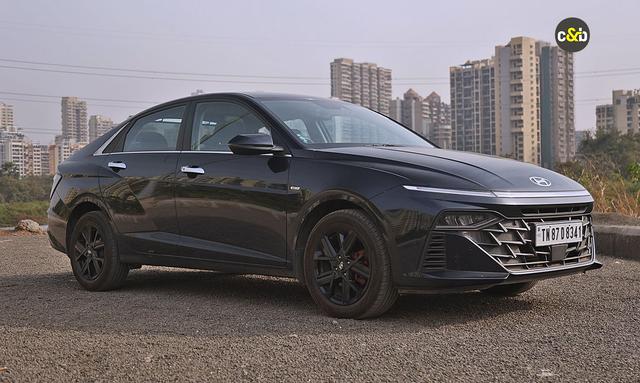 Girish Karkera | Mar 4, 20248000 km Long Term Review: 2023 Hyundai Verna SX(O) Turbo/DCTOur long-term Hyundai Verna has completed 8000 km on the Odometer, and it is now time to tell you what's it like to live with this sedan1 mins
Girish Karkera | Mar 4, 20248000 km Long Term Review: 2023 Hyundai Verna SX(O) Turbo/DCTOur long-term Hyundai Verna has completed 8000 km on the Odometer, and it is now time to tell you what's it like to live with this sedan1 mins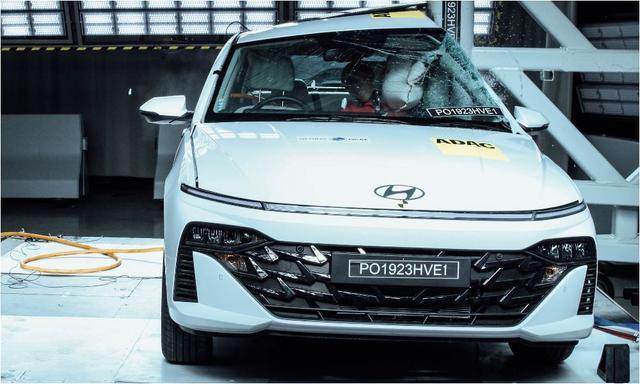 Amaan Ahmed | Oct 3, 2023Hyundai Verna Secures Five-Star Rating In Global NCAP Crash TestsScoring high marks for both adult as well as child occupant protection, the Verna has become the first Hyundai to receive a five-star GNCAP rating.4 mins
Amaan Ahmed | Oct 3, 2023Hyundai Verna Secures Five-Star Rating In Global NCAP Crash TestsScoring high marks for both adult as well as child occupant protection, the Verna has become the first Hyundai to receive a five-star GNCAP rating.4 mins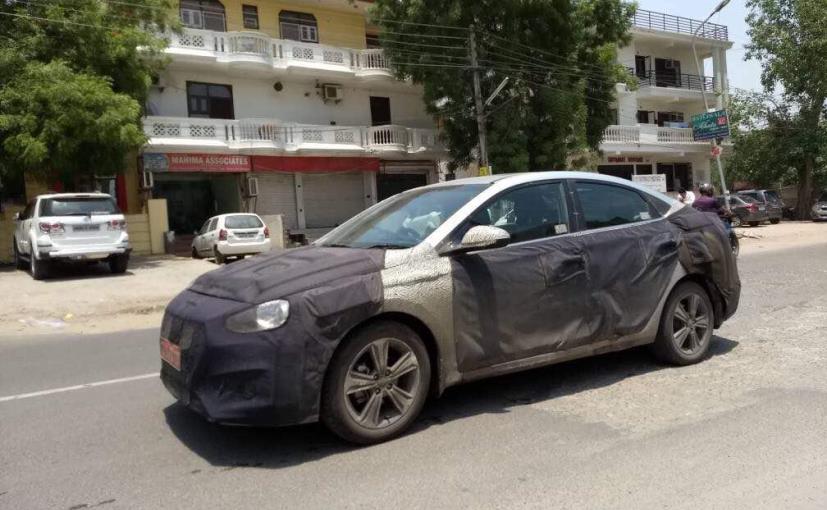 Seshan Vijayraghvan | Sep 27, 2023New 2017 Hyundai Verna Spotted Testing In India2017 Hyundai Verna was recently spotted testing in India for the first time and as expected, it was completely camouflaged. Hyundai Verna will be launched in India later this year and rival the likes of Maruti Suzuki Ciaz, Honda City and the Volkswagen Vento.2 mins
Seshan Vijayraghvan | Sep 27, 2023New 2017 Hyundai Verna Spotted Testing In India2017 Hyundai Verna was recently spotted testing in India for the first time and as expected, it was completely camouflaged. Hyundai Verna will be launched in India later this year and rival the likes of Maruti Suzuki Ciaz, Honda City and the Volkswagen Vento.2 mins
Used Hyundai Cars
- 2019 Hyundai Creta1.6 E Plus PetrolYozna Vihar, New DelhiDL07
1st Owner
Petrol
39,970 Kms
Manual
₹ 8.25 LakhEMI starts at₹ 18,477 /Month - 2022 Hyundai VenueS 1.2 PetrolYozna Vihar, New DelhiDL07
1st Owner
Petrol
27,685 Kms
Manual
₹ 6.90 LakhEMI starts at₹ 14,595 /Month - 2022 Hyundai Creta1.5 SX Executive Trim PetrolYozna Vihar, New DelhiDL05
1st Owner
Petrol
44,525 Kms
Manual
₹ 12.75 LakhEMI starts at₹ 26,963 /Month - 2023 Hyundai i201.2 Asta Petrol MTYozna Vihar, New DelhiDL3C
1st Owner
Petrol
21,952 Kms
Manual
₹ 8.25 LakhEMI starts at₹ 18,477 /Month - 2019 Hyundai Elite i201.2 Magna Plus Petrol BS IVYozna Vihar, New DelhiDL07
2nd Owner
Petrol
69,389 Kms
Manual
₹ 6.25 LakhEMI starts at₹ 13,998 /Month - 2018 Hyundai Creta1.6 E Plus PetrolRohini Courts, New DelhiDL05
1st Owner
Petrol
61,212 Kms
Manual
₹ 7.35 LakhEMI starts at₹ 16,461 /Month - 2022 Hyundai Creta1.5 EX Petrol [2020-2023]Mansarover Garden, New DelhiDL10
1st Owner
Petrol
14,000 Kms
Manual
₹ 10.75 LakhEMI starts at₹ 22,732 /Month
Sell Your Car On C&B
Quick, Easy and Maximum Price – Share Car Details, get Price in 5 Minutes, Schedule Home Inspection & Sell in 1 Day
Explore Popular Hyundai Cars
 Hyundai Creta+67 Variants
Hyundai Creta+67 Variants- Petrol+1 More
- Manual, Automat…
- 17.4 KM/L
* Ex-Showroom₹ 10.73 - 19.79 LEMI starts at₹ 22,265 Hyundai Exter+44 Variants
Hyundai Exter+44 Variants- Petrol+1 More
- Manual, AMT
- 19.4 KM/L
* Ex-Showroom₹ 5.49 - 9.57 LEMI starts at₹ 11,391 Hyundai Elite i20+18 Variants
Hyundai Elite i20+18 Variants- Petrol
- Manual, CVT, IV…
- 19.65 KM/L
* Ex-Showroom₹ 6.87 - 10.52 LEMI starts at₹ 14,258 Hyundai Venue+30 Variants
Hyundai Venue+30 Variants- Petrol+1 More
- Manual, DCT
- 17.5 KM/L
* Ex-Showroom₹ 7.26 - 12.46 LEMI starts at₹ 15,078 Hyundai Grand i10 Nios+16 Variants
Hyundai Grand i10 Nios+16 Variants- Petrol+1 More
- Manual, AMT
- 20.2 KM/L
* Ex-Showroom₹ 5.47 - 7.92 LEMI starts at₹ 11,361
Hyundai New Verna Alternatives
 Maruti Suzuki Ciaz+9 Variants
Maruti Suzuki Ciaz+9 Variants- Petrol
- Manual
- 20.04 KM/L
* Ex-Showroom₹ 10.32 - 13.99 LEMI starts at₹ 21,426

 Volkswagen Virtus+3 Variants
Volkswagen Virtus+3 Variants- Petrol
- Manual
- 18.67 KM/L
* Ex-Showroom₹ 12.36 - 15.99 LEMI starts at₹ 25,665 Maruti Suzuki 2025 New Dzire+8 Variants
Maruti Suzuki 2025 New Dzire+8 Variants- Petrol
- Manual
- 22 KM/L
* Ex-Showroom₹ 7.45 - 11.58 LEMI starts at₹ 15,455
Upcoming Hyundai Cars
Hyundai New Verna FAQs
Any Questions? Ask the Expert
Latest Videos on New Verna
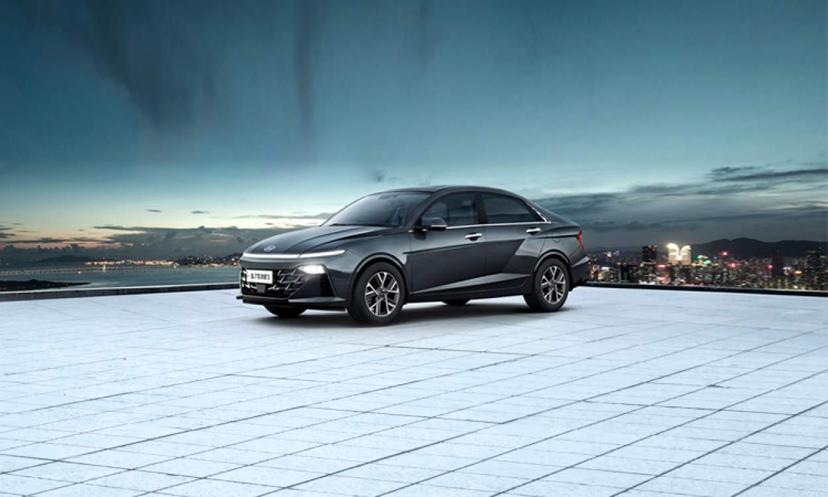 2023 Hyundai Verna Review: Both Petrol Engines Driven2 years ago | 11:1043460 Views
2023 Hyundai Verna Review: Both Petrol Engines Driven2 years ago | 11:1043460 Views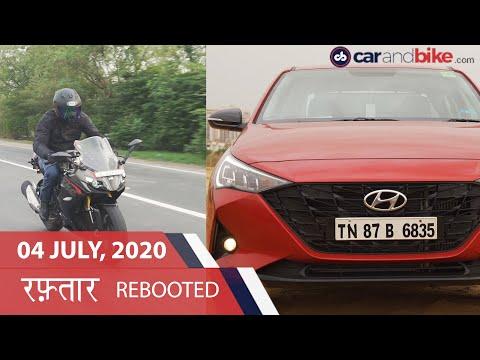 Hyundai Verna Review, TVS Apache RR 310 | Raftaar Rebooted5 years ago | 14:422694 Views
Hyundai Verna Review, TVS Apache RR 310 | Raftaar Rebooted5 years ago | 14:422694 Views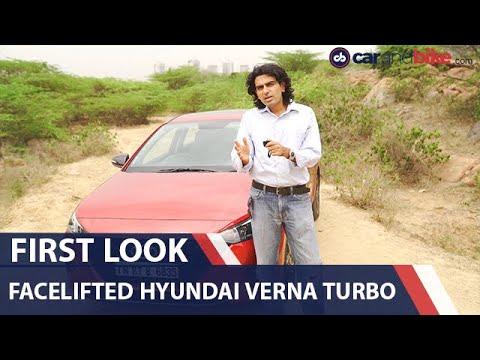 Hyundai Verna Facelift: First Look | carandbike5 years ago | 03:1711368 Views
Hyundai Verna Facelift: First Look | carandbike5 years ago | 03:1711368 Views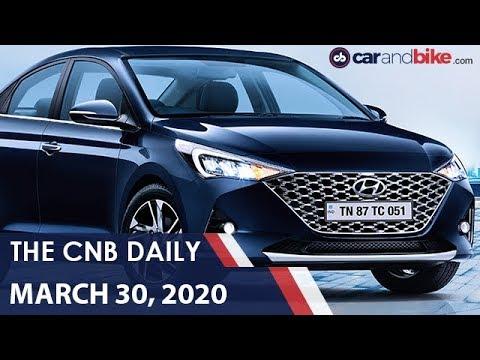 Hyundai Verna Launched | Royal Enfield Meteor 350 | Mahindra Face Shield5 years ago | 03:0811332 Views
Hyundai Verna Launched | Royal Enfield Meteor 350 | Mahindra Face Shield5 years ago | 03:0811332 Views 2020 Hyundai Verna Bookings | Royal Enfield JD1 | BS6 Bajaj Dominar5 years ago | 03:1215870 Views
2020 Hyundai Verna Bookings | Royal Enfield JD1 | BS6 Bajaj Dominar5 years ago | 03:1215870 Views

